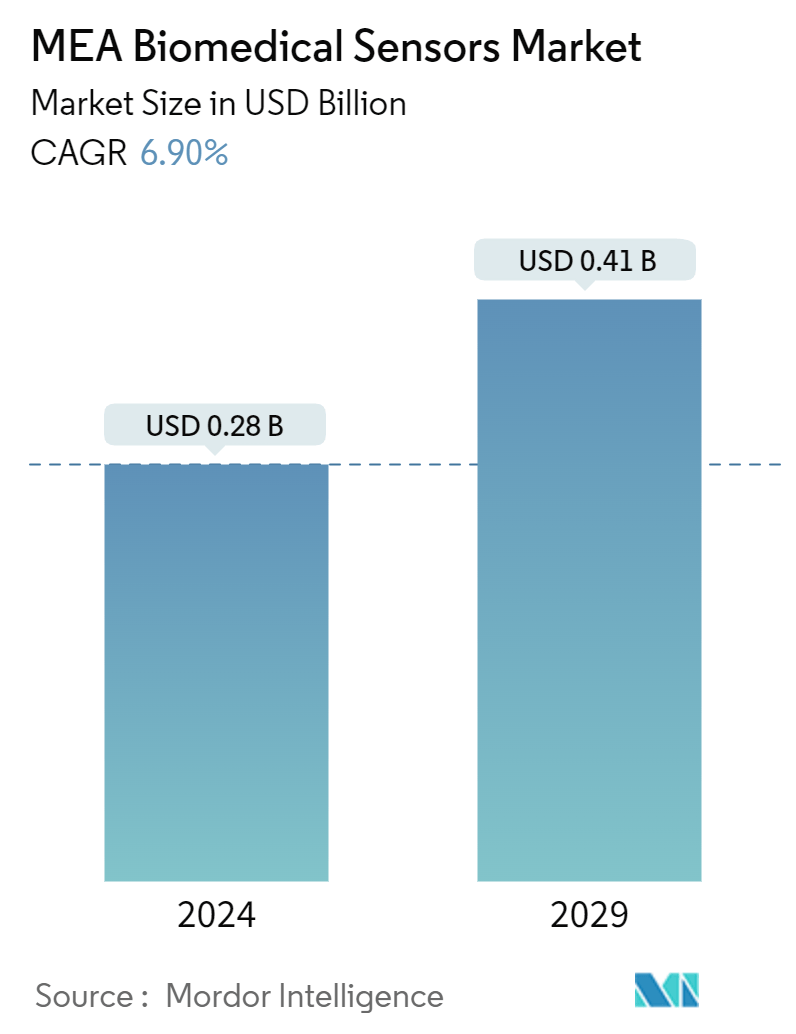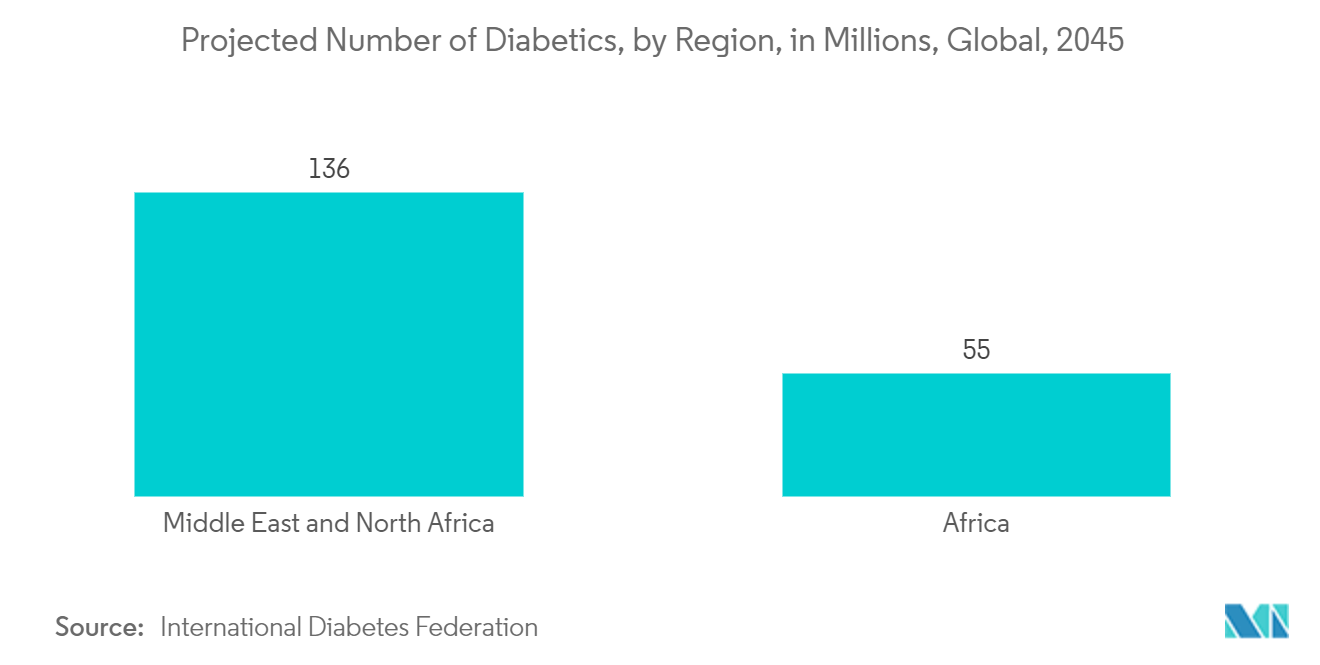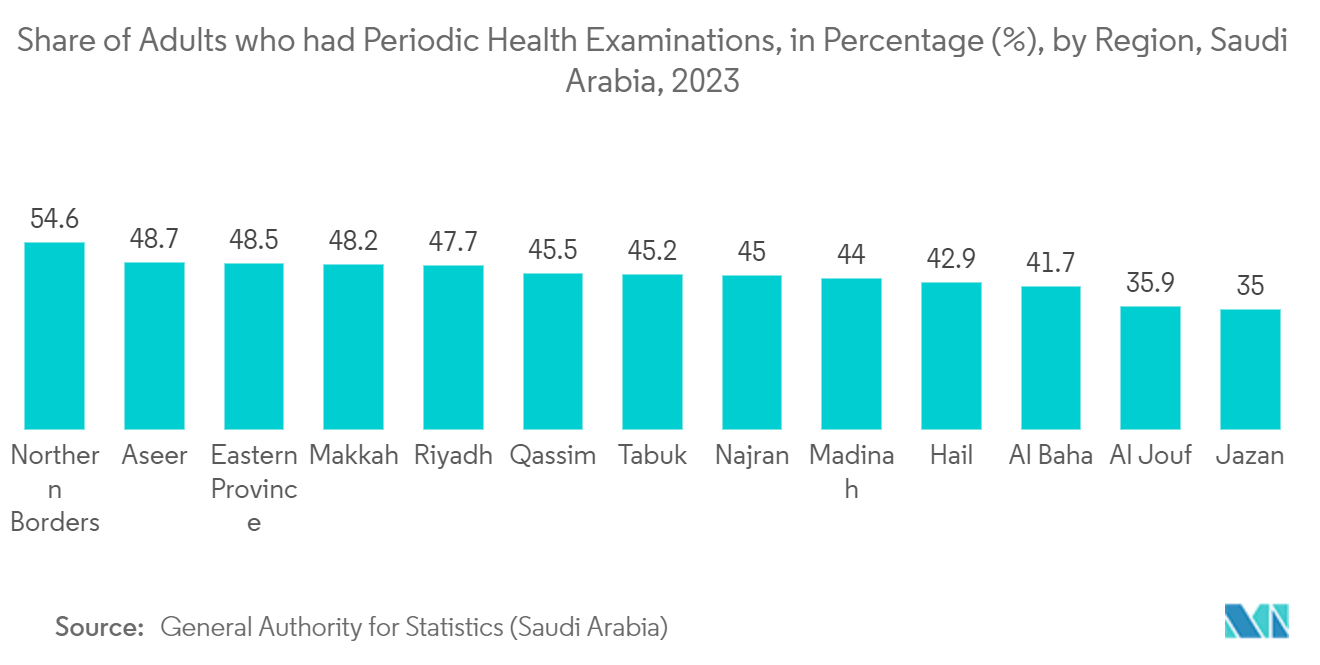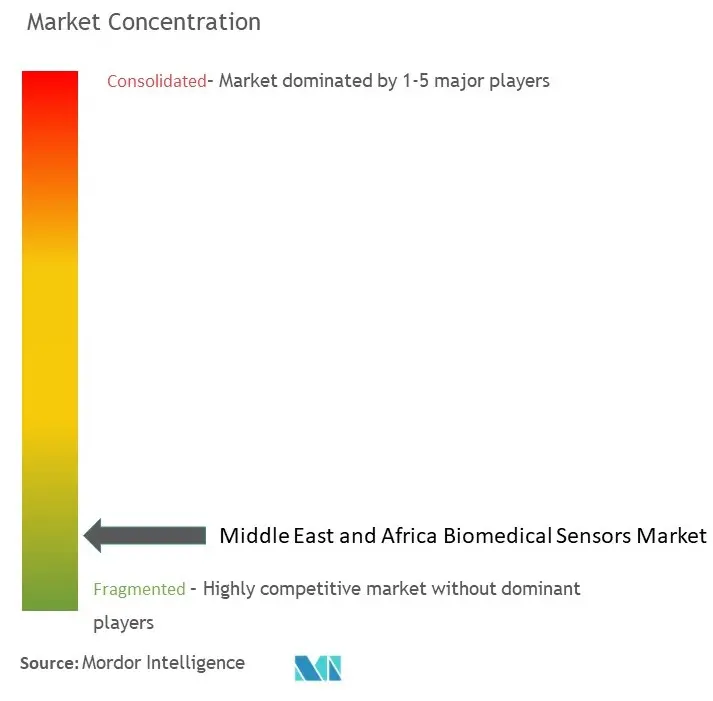MEA Biomedical Sensors Market Size

| Study Period | 2019 - 2029 |
| Base Year For Estimation | 2023 |
| Market Size (2024) | USD 0.28 Billion |
| Market Size (2029) | USD 0.41 Billion |
| CAGR (2024 - 2029) | 6.90 % |
| Market Concentration | Low |
Major Players
*Disclaimer: Major Players sorted in no particular order |
MEA Biomedical Sensors Market Analysis
The MEA Biomedical Sensors Market size is estimated at USD 0.28 billion in 2024, and is expected to reach USD 0.41 billion by 2029, growing at a CAGR of 6.90% during the forecast period (2024-2029).
Biomedical sensors are made to send out alerts when they spot irregular readings, check for toxic substances in the blood, or infiltrate drugs right into the circulatory system. Investments in creating sensors with these characteristics are vital drivers of the market studied.
- The biomedical sensors market is driven by the expanded demand in hazardous environments, utilization in situations resulting from natural disasters, augmented demand in the healthcare sector for diabetic and heart patients, and implanted monitoring of the patients. Technological advancements have made it possible to build biomedical sensors using nano and microtechnology, making them small, robust, smart, and cost-effective. The early detection of irregularities in the health status of the patients will contribute to a better quality of life.
- Antimicrobial resistance, poor lifestyles, alcohol consumption, and smoking contribute to the increased prevalence of lifestyle-related disorders, including diabetes. According to IDF Diabetes Atlas, 1 in 6 adults (73 million) live with diabetes in the Middle East and North Africa. Furthermore, the number of adults with diabetes is predicted to reach 95 million by 2030 and 136 million by 2045. As a result, the requirement for biomedical sensors for routine health monitoring is growing.
- The growing awareness concerning healthcare has increased the need for sensor technologies and monitoring appliances that can sense and deliver feedback to users about their health status for increased safety, which may further drive the growth of the market studied.
- Even though biomedical sensors play a significant role in life-saving situations, they face specific challenges, such as patient safety and comfort due to strong electromagnetic fields, transferring energy from external to inner parts with high efficiency and increased data rates, limited computation and data storage, and ultra-low energy consumption.
- The Russia-Ukraine War is impacting the supply chain of semiconductors and electronic components, being a significant supplier of raw materials for producing semiconductors and electronic components, including various sensors. The dispute has disrupted the supply chain, causing shortages and price increases for these materials, impacting biomedical sensor manufacturers and potentially leading to higher costs for end users.
MEA Biomedical Sensors Market Trends
Growing Demand for Fitness Devices to Drive the Market
- The incidence and prevalence of lifestyle-related illnesses, such as diabetes and hypertension, are anticipated to rise over the forecast period due to the sedentary lifestyle of people. Several physiological factors, such as blood sugar levels and blood pressure, should be continuously monitored in some of these disorders. This enables the integration of healthcare data with portable medical equipment, which may then be provided to clinicians for real-time data access and error reduction.
- Furthermore, the rising death rate from noncommunicable illnesses is a significant source of concern, necessitating a greater focus on tailored monitoring and care. This is expected to boost demand for wearable medical devices and the research industry in the long run. According to WHO, the four main NCDs are causative of the demise of around 4,800 people in the UAE annually, and the chance of dying before age 70 from NCDs is nearly one in five.
- Wearable biomedical sensors are gaining interest nowadays, and it is a remarkable development in the sector of wearable health technology. These sensors are digital devices that can be worn on the body and allow blood glucose levels, blood pressure, heartbeat rate, and other biometric data to be calculated continuously and constantly.
- Furthermore, in September 2023, Emirates Global Aluminum announced that it had expanded the use of Kenzen, a wearable technology platform, to 350 employee volunteers to "Beat the Heat" in the summer. Kenzen's wearable technology has the potential to protect outdoor workers in the UAE by continuously reporting body temperature, heart rate, activity, and other body indicators, allowing both the user and EGA's safety team to avoid heat stress in the body by recognizing signs.
- In addition, according to the International Diabetes Federation, the number of people with diabetes is increasing in the Middle East and Africa, and by 2045, MENA is expected to have 136 people with diabetes.
- The rising frequency of chronic diseases, as well as rising death rates, is a significant source of concern for both individuals and government agencies. As a result, healthcare practitioners can provide tailored care that includes ongoing and remote patient monitoring. These can also be worn for up to 24 hours without interfering with daily activities. As a result of the numerous benefits it provides, the demand for wearable medical devices, as well as the studied market, is expected to increase over the projection period.
- The industry is expected to expand with the rise in popularity of the Internet of Things. The advent of new technologies and the introduction of innovative products in favor of customers at reasonable rates are also driving demand for fitness trackers in the Middle East and Africa. The growing trend of recording and monitoring the number of steps walked, heart rate, sleep duration, and calories burned when exercising or participating in sports activities is expected to enhance the demand for fitness trackers in the Middle East and Africa.

Saudi Arabia Expected to Witness Significant Growth
- The increasing prevalence of lifestyle disease and growing focus on primary healthcare, preventative care, and specialized clinics would fuel the demand for biomedical pressure sensors in Saudi Arabia. The country is witnessing increased development of private hospitals, clinics, and digital health services, further expanding the deployment of monitoring and diagnostics devices.
- Saudi Arabia has experienced significant growth in its healthcare sector due to large investments in recent years. Increased government spending and private sector involvement have improved the quality of healthcare infrastructure to meet surging demand.
- Rising demand for remote patient monitoring solutions due to the aging population and long-lasting chronic diseases are the major factors propelling the market growth. The demand for diagnostics and monitoring devices has been growing, especially in rehabilitation clinics, mental healthcare facilities, and dialysis centers, offering new opportunities to the vendors in the market.
- According to the General Authority for Statistics (Saudi Arabia), in 2023, 55% of adults in Northern Borders in Saudi Arabia had periodic health examinations. Between 40 and 49% of adults in 10 of the 13 regions had regular health check-ups. Jazan was the region with the least share of periodic health examinations among adults, at 35%.
- Saudi Arabia's Vision 2030 defines healthcare as one of the critical pillars of development and sets goals and strategies to improve healthcare access and quality. Building advanced infrastructure is critical, and the government has asked the private sector to invest approximately USD 66 billion to make it happen. This makes Saudi Arabia the most promising healthcare market in the Middle East.
- According to the National Institute of Health (NIH), in Saudi Arabia, non-communicable diseases account for 73% of all deaths. Cardiovascular diseases are the leading cause of NCD deaths, accounting for 37% of total deaths, followed by cancer at 10%, then diabetes at 3%, respiratory diseases at 3%, and other NCDs at 20%. The country aims to continue to increase its spending to prevent and treat lifestyle disorders and diabetes. In addition, the Saudi medical equipment market has an estimated value of USD 2 billion and is growing annually at approximately 10%.

MEA Biomedical Sensors Industry Overview
The Middle East and Africa biomedical sensors market is highly fragmented due to the presence of both global players and small and medium-sized enterprises. Some of the major players in the market are NXP Semiconductors, GE HealthCare Technologies, Inc., Honeywell International Inc., Analog Devices, Inc., and Medtronic. Players in the market are adopting strategies such as partnerships and acquisitions to enhance their product offerings and gain sustainable competitive advantage.
- In October 2023, the Ministry of Investment Saudi Arabia signed eight MoUs, valued at USD 1.07 billion, with seven international and local companies. These agreements will lead to the localization of the supply chain for advanced medical devices, encompassing stents, sutures, and sensors.
- In August 2023, GE HealthCare announced that the FDA cleared its Portrait VSM vital signs monitor, which allows hospitals to continuously monitor critical signs and enable patients to walk around their wards. Wireless sensors that the patients wear are combined with a smartphone-style monitor in the Portrait device.
MEA Biomedical Sensors Market Leaders
-
NXP Semiconductors
-
GE HealthCare Technologies, Inc.
-
Honeywell International Inc.
-
Analog Devices Inc.
-
Medtronic
*Disclaimer: Major Players sorted in no particular order

MEA Biomedical Sensors Market News
- August 2024 - Medtronic Diabetes has been approved by the FDA for a new continuous glucose monitoring device and has teamed up with Abbott Diabetes Care for a future CGM device to be used with Medtronic products. The FDA has given the green light for Medtronic's Simplera CGM device, which is meant to work with the company's Smart Multiple Daily Injection system with InPen. Medtronic intends to present the app to the FDA for approval to allow integration with InPen. The FDA is also currently reviewing the Simplera Sync sensor created by the company, which is meant to work with the MiniMed 780G hybrid closed-loop insulin delivery system.
- Januray 2024 - edtronic plc revealed that the MiniMed™ 780G system with Simplera Sync™, an all-in-one continuous glucose monitor (CGM) that is disposable and does not need fingersticks or overtape, has been granted CE (Conformité Européenne) Mark approval. Simplera Sync™ offers a better user interface with a straightforward, two-step insertion procedure and is half the size of older Medtronic sensors.
MEA Biomedical Sensors Market Report - Table of Contents
1. INTRODUCTION
- 1.1 Study Assumptions and Market Definition
- 1.2 Scope of the Study
2. RESEARCH METHODOLOGY
3. EXECUTIVE SUMMARY
4. MARKET INSIGHTS
- 4.1 Market Overview
-
4.2 Industry Attractiveness - Porter's Five Forces Analysis
- 4.2.1 Threat of New Entrants
- 4.2.2 Bargaining Power of Buyers
- 4.2.3 Bargaining Power of Suppliers
- 4.2.4 Threat of Substitute Products
- 4.2.5 Intensity of Competitive Rivalry
- 4.3 Supply Chain Analysis
- 4.4 Impact of Macroeconomic Trends on the Market
5. MARKET DYNAMICS
-
5.1 Market Drivers
- 5.1.1 Growing Demand for Fitness Devices
- 5.1.2 Increasing Spending on Diagnostics
-
5.2 Market Restraints
- 5.2.1 High Costs of the Systems
6. MARKET SEGMENTATION
-
6.1 By Type
- 6.1.1 Wired
- 6.1.2 Wireless
-
6.2 By Sensor Type
- 6.2.1 Temperature
- 6.2.2 Pressure
- 6.2.3 Image Sensors
- 6.2.4 Biochemical
- 6.2.5 Inertial Sensors
- 6.2.6 Motion Sensors
- 6.2.7 Electrocardiogram (ECG)
-
6.3 By Industry
- 6.3.1 Pharmaceutical
- 6.3.2 Healthcare
-
6.4 By Country
- 6.4.1 Saudi Arabia
- 6.4.2 South Africa
- 6.4.3 United Arab Emirates
7. COMPETITIVE LANDSCAPE
-
7.1 Company Profiles*
- 7.1.1 NXP Semiconductors
- 7.1.2 GE HealthCare Technologies Inc.
- 7.1.3 Honeywell International Inc.
- 7.1.4 Analog Devices Inc.
- 7.1.5 Medtronic
- 7.1.6 Smiths Medical
- 7.1.7 STMicroelectronics NV
- 7.1.8 TE Connectivity
- 7.1.9 Pinnacle Technology Inc.
- 7.1.10 Sensirion AG
- 7.1.11 RESONETICS
8. INVESTMENT ANALYSIS
9. FUTURE OF THE MARKET
** Subject To AvailablityMEA Biomedical Sensors Industry Segmentation
Biomedical sensors are special electronic devices that transduce biomedical signals into easily measurable electric signals. Biomedical sensors are critical components in various medical diagnostic instruments and equipment.
The biomedical sensors market in the Middle East and Africa is segmented by type (wired, wireless), sensor type (temperature, pressure, image sensor, biochemical, inertial sensor, motion sensor, and electrocardiogram), industry (pharmaceutical and healthcare), and country (Saudi Arabia, South Africa, and the United Arab Emirates). The report offers market forecasts and size in value (USD) for all the above segments.
| By Type | Wired |
| Wireless | |
| By Sensor Type | Temperature |
| Pressure | |
| Image Sensors | |
| Biochemical | |
| Inertial Sensors | |
| Motion Sensors | |
| Electrocardiogram (ECG) | |
| By Industry | Pharmaceutical |
| Healthcare | |
| By Country | Saudi Arabia |
| South Africa | |
| United Arab Emirates |
MEA Biomedical Sensors Market Research FAQs
How big is the MEA Biomedical Sensors Market?
The MEA Biomedical Sensors Market size is expected to reach USD 0.28 billion in 2024 and grow at a CAGR of 6.90% to reach USD 0.41 billion by 2029.
What is the current MEA Biomedical Sensors Market size?
In 2024, the MEA Biomedical Sensors Market size is expected to reach USD 0.28 billion.
Who are the key players in MEA Biomedical Sensors Market?
NXP Semiconductors, GE HealthCare Technologies, Inc., Honeywell International Inc., Analog Devices Inc. and Medtronic are the major companies operating in the MEA Biomedical Sensors Market.
What years does this MEA Biomedical Sensors Market cover, and what was the market size in 2023?
In 2023, the MEA Biomedical Sensors Market size was estimated at USD 0.26 billion. The report covers the MEA Biomedical Sensors Market historical market size for years: 2019, 2020, 2021, 2022 and 2023. The report also forecasts the MEA Biomedical Sensors Market size for years: 2024, 2025, 2026, 2027, 2028 and 2029.
MEA Biomedical Sensors Industry Report
Statistics for the 2024 MEA Biomedical Sensors market share, size and revenue growth rate, created by Mordor Intelligence™ Industry Reports. MEA Biomedical Sensors analysis includes a market forecast outlook to 2029 and historical overview. Get a sample of this industry analysis as a free report PDF download.



